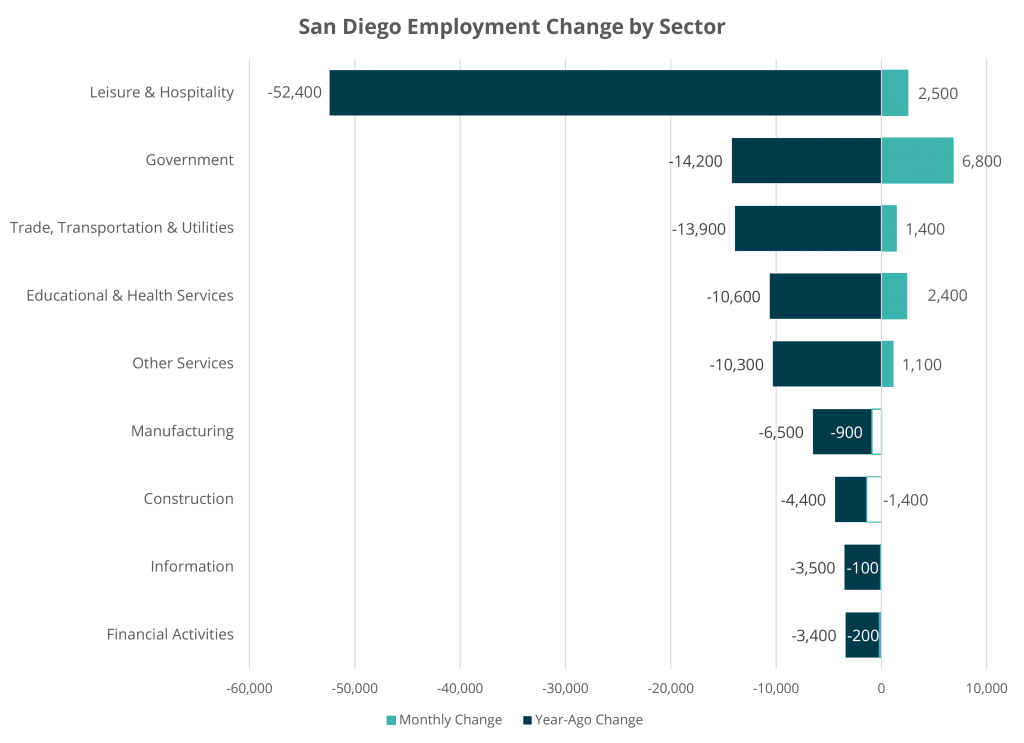Each month the California Employment Development Department (EDD) releases employment data for the prior month. This edition of San Diego’s Economic Pulse covers September 2020 and reflects some effects of the coronavirus pandemic on the labor market. Check out EDC’s research bureau for more data and stats about San Diego’s economy.
Key Takeaways
- Unemployment falls to 9.0 percent.
- Long-term unemployment continues to increase.
- Investments in workforce development and retraining become increasingly more important.
Labor Market Overview
The region’s unemployment rate was 9.0 percent in September down from a revised 9.5 percent in August 2020, and still three times above the year-ago estimate of 2.9 percent. Unemployment continues to increase in San Diego’s unincorporated and low income areas, while falling in wealthier areas. The highest unemployment area in the region was Bostonia at 16.5 percent and the lowest was Solana Beach at 5.0 percent.
The region’s unemployment rate remains lower than California’s unemployment rate of 10.8 percent, but higher than the national unemployment rate of 7.7 percent.
Looking at monthly employment, total nonfarm employment increased by 11,700 in September. Government accounted for the largest monthly gains, adding 6,800 jobs last month, primarily concentrated in local government education (up 5,300 jobs). Even so, compared to a year ago, local government education is still down 11,700 jobs. Leisure and hospitality followed with an increase of 2,500 jobs. Job gains were driven by accommodation and food services, which added 3,200 jobs. These gains were offset by a loss of 700 jobs in arts, entertainment, and recreation. Educational and health services increase this month, adding 2,400 jobs.
Compared to a year ago, San Diego nonfarm employment remains down 117,700 jobs, or 7.8 percent. Leisure and hospitality represents the largest share, down 52,400 jobs. Accommodation is down 14,000 jobs over the year, and bars and restaurants are down 24,400.

Long-Term Unemployment Continues to Increase
Long-term unemployment has increased substantially during the past few months of the pandemic, though it remains significantly lower than the peak experience in the Great Recession of 2007-2009. In September, the number of unemployed persons in the U.S. who were jobless for 27 weeks or more increased by 781,000 to 2.4 million. During the Great Recession, the highest rate of long-term unemployment was 6.8 million in April 2010.
Long-term joblessness can have a significant impact on workers’ future career prospects. If out of work long enough, skills become outdated. Moreover, long-term unemployed workers often face continual earnings losses, earnings volatility, and more frequent unemployment throughout their careers. Finally, long-term joblessness greatly increases the risk of workers leaving the workforce altogether, which can have lasting economic impacts.
Workforce development and retraining are becoming increasingly more important, especially as more workers face long-term unemployment. Jobs currently in high demand include software developers and software quality assurance analysts and testers, registered nurses, and retail salespersons and supervisors, which had the highest total job postings in September. While the hiring of retail might be a good sign, this may be due to the reopenings of stores and retail which will eventual level off. The top in-demand skills include merchandising, auditing, accounting, and selling techniques. Working to adjust these skills to the changing work environment is essential. Read more about workforce development and retraining, and how EDC is playing a part.
For more COVID-19 recovery resources and information, please visit this page.
EDC is here to help. You can use the button below to request our assistance with finding information, applying to relief programs, and more.
You also might like: